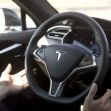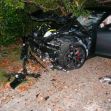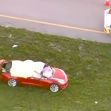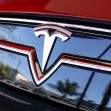Tesla is facing yet another lawsuit over its autonomous driving technology after a Colorado man was killed in a fiery crash when his Tesla veered off the road and drove into a tree.
The crash happened in 2022 when 33-year-old Hans Von Ohain was behind the wheel of his Tesla Model 3 with a friend, Erik Rossiter, as the two were returning home from a day of golfing. Von Ohain, who was also a Tesla employee working as a recruiter, was intoxicated at the time and was using his vehicle’s autopilot system to drive. An autopsy would later reveal that Von Ohain’s blood alcohol was three times the legal limit.
Rossiter, who suffered severe injuries but survived the crash, says that the Autopilot system was in use when the crash happened. The lawsuit explains that the autonomous driving system “unexpectedly caused the 2021 Tesla Model 3 to sharply veer to the right, leading it off the pavement” on Upper Bear Creek Road. Recorded data would later show that the Tesla was Driving 41 MPH, slightly about the 40 MPH speed limit at the time of the crash.
Rossiter explained that when the vehicle veered, Ohain struggled to regain control of the vehicle. Rossiter also shared with responding officers that on the way to the golf course, the vehicle was driving with its autonomous driving system and that “the car would swerve off toward the side of the road periodically and bring itself back.” He called the drive “uncomfortable,” and “a bit nerve-wracking.”
The lawsuit was filed on behalf of Von Ohain’s Widow Nora Bass and Von Ohain’s only child on May 3 in Clear Creek County District Court.
In February, Bass shared with the Washington Post that she was unable to find an attorney to take her case because her husband was intoxicated at the time of the crash. However, she maintains that Tesla needs to be held responsible for its actions in producing and marketing self-driving technology to drivers without giving a full scope of ramifications when the autonomous driving system is in use.
She shares with the Post, “Regardless of how drunk Hans was, Musk has claimed that this car can drive itself and is essentially better than a human. We were sold a false sense of security.”
Tesla vehicles offer two driver assistance technologies; Autopilot and Full Self Driving (FSD). Both systems are designed to help drivers by providing self-driving assistance, with the full self-driving technology offering more advanced self-driving features.
Bass says that the FSD tech, which was in use when her husband was driving, is misleading to customers because it gives the impression that the vehicle can drive itself when in reality it cannot. The lawsuit cites the company’s 2016 promotional video in support of this claim. The complaint reads, “By showcasing a Tesla vehicle navigating traffic without any hands on the steering wheel, Tesla irresponsibly misled consumers into believing that their vehicles possessed capabilities far beyond reality.”
Tesla has previously shared that despite the names of the technologies, the technology should not be used in place of the driver and will still require driver attention to operate safely.
Tesla began recording the number of crashes involving driver assistance technologies and has reported over 900 accidents. There have been at least 40 serious or fatal injuries as a result.
If the lawsuit proves successful that Von Ohain’s accident was the result of Tesla’s autonomous driving system, it would be the first recorded death involving the Full Self Driving technology.






